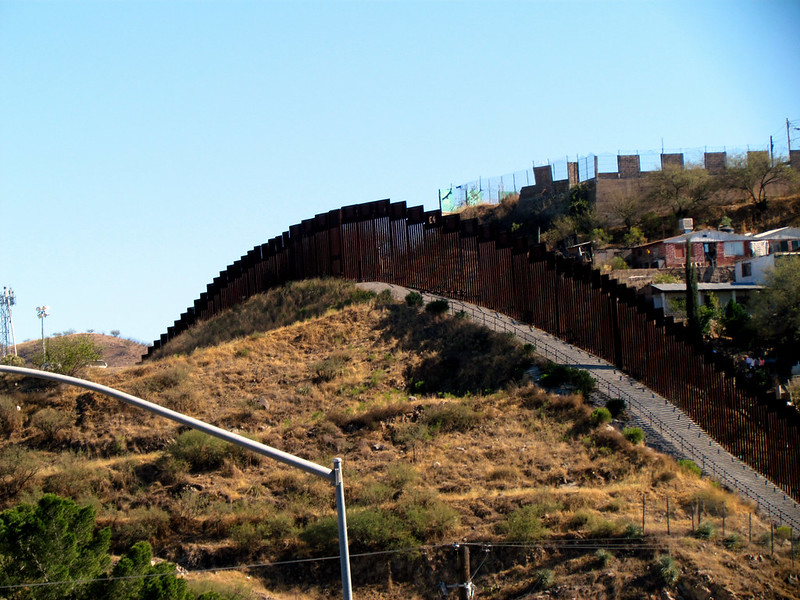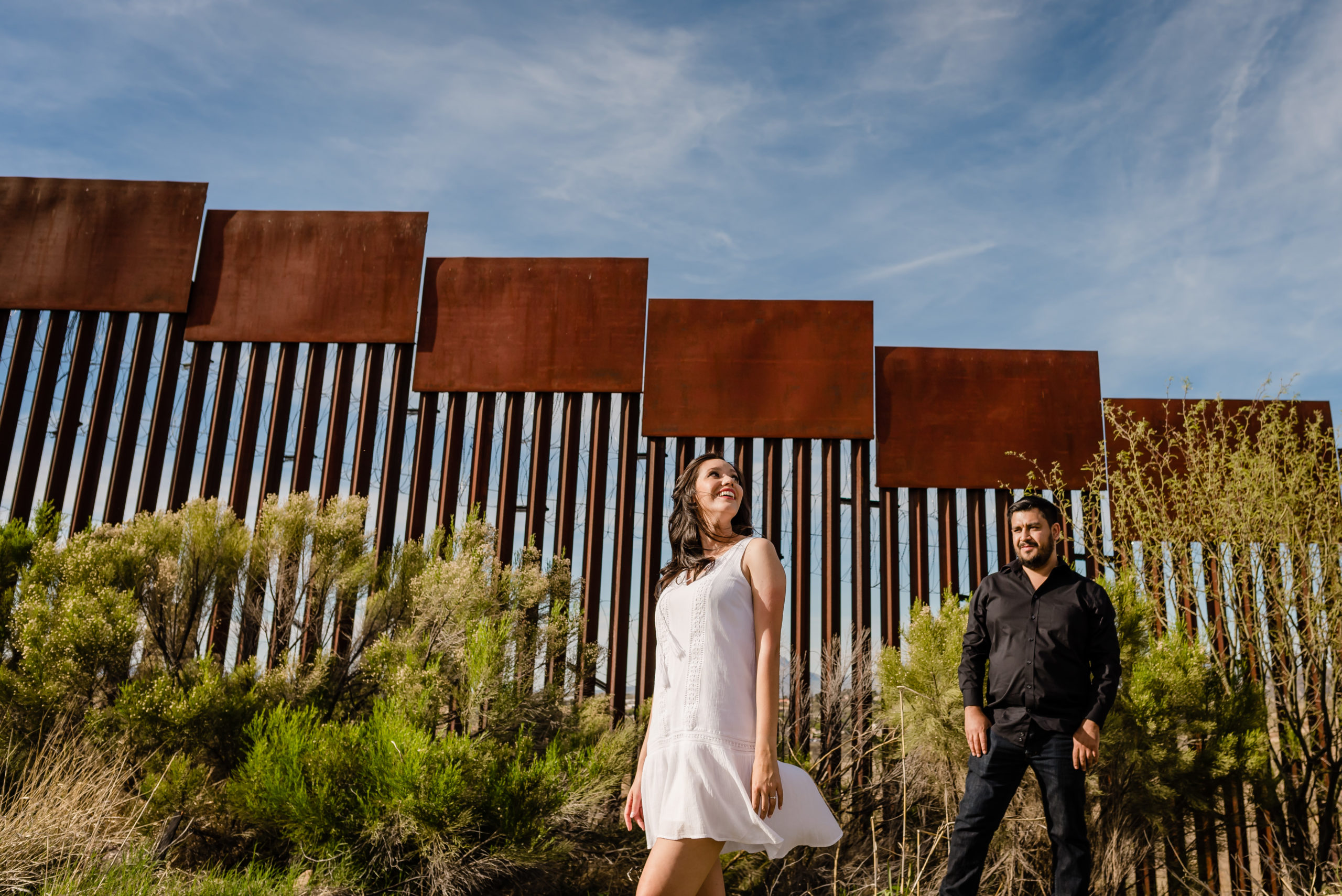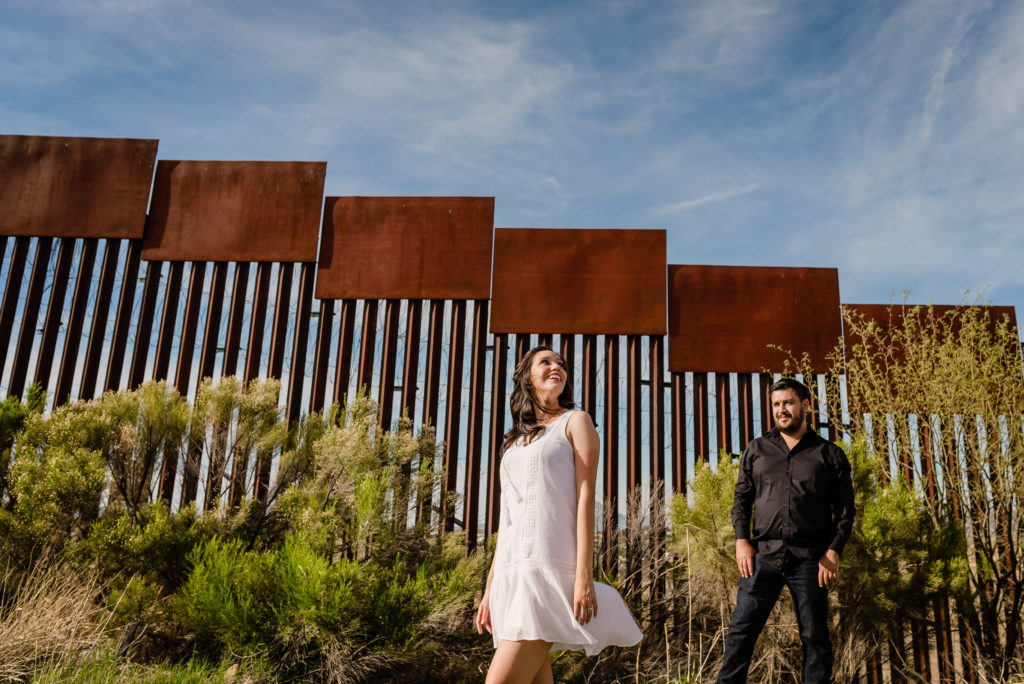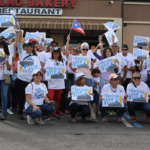This story was produced in partnership with Slate.
Elliot Vernet did not believe in marriage. A biomedical engineer in Hermosillo, Mexico, he was a workaholic with no time for serious relationships. He was always busy — packing and unpacking, living in laboratories and airports.
In 2017, Vernet went to Pal Norte!, a popular music festival in Monterrey, Mexico. In a crowd of people, music and chaos, he looked up and saw her. She looked just like she did in high school…maybe even better. He stopped breathing for a second. “Hi, do you remember me?”
That year, Yadelle García was trying to reinvent herself. She’d divorced her husband of ten years and moved from California back to Nogales, Arizona, the sister city to Nogales, Sonora, the Mexican border town where she grew up. García is a graphic designer with a boisterous, hearty laugh.
Besides a number of freelance jobs, she consulted at a well-known bridal boutique in town because she loved to experience romance through other couples’ eyes. She often wondered if she would ever find love again, but she didn’t lose hope. García was also a fan of Mexican music. That’s why she had traveled to Monterrey to attend Pal Norte! A thrill ran through her as she spotted him: her high school crush. “Of course I remember you!”
The encounter at the music festival would result, two years later, in a wedding. Actually, two weddings. Vernet is a Mexican citizen and García holds dual citizenship in Mexico and the United States. In May 2019, they hosted a big Mexican celebration in Hermosillo, Vernet’s hometown, followed by a civil ceremony last November at a courthouse in Nogales, Arizona.

Photo by Beto Robles
Since getting married, the couple, now 38, had spent holidays together, but because Vernet is not authorized to live and work in the U.S., they still lived mostly separately in two different countries. They weren’t in a hurry to get Vernet a green card before the coronavirus became a pandemic. But since the rise of COVID-19, governments across the globe are shutting down borders. On March 20, President Donald Trump and Secretary of State Mike Pompeo announced a partial closure of the borders with Canada and Mexico.
García had been getting nervous as more confirmed cases were reported in Arizona and as schools and businesses shut down across the state. “Since he is still living in Hermosillo, I asked him to come to Nogales, so we could stay on this side of the border during the COVID-19 quarantine,” García said.
Vernet thought it was a good idea to join García. He works in the biomedical field and knew that he had a lot of work ahead of him with the coronavirus spreading across the world, especially in Arizona and Mexico. So on March 21, García drove to Sonora to pick her husband up. Non-essential travel restrictions began that same day.
“Essential” means U.S. citizens and permanent residents returning home. It includes individuals who travel for work, for educational reasons or verifiable medical emergencies. Only members of the military and international trade agents can enter the United States, but U.S. citizens can leave at any time.
Vernet has a B1 / B2 tourist visa and a pending petition for permanent residency with USCIS, the United States Customs and Immigration Services.
“I thought that was enough to cross the border,” he said.
The Mariposa Port of Entry, connecting Arizona and the Mexican state of Sonora, was quiet; not many people were trying to cross. On a typical day, the wait can be more than two hours.
They managed to get past the first of three checkpoints: Documents, interviews and a vehicle check.
But at the second checkpoint, García says she told the Customs and Border Protection agent that she is a U.S. citizen and that her husband was coming to stay with her for at least a week. They showed the agent Elliot’s visa, his USCIS receipt and their marriage certificate.
“He even brought documents from his company in Hermosillo to prove that he would return to Mexico,” García said.
But none of those documents mattered, because Vernet wasn’t on the “essential travel” list.
The agent told them that García could cross the border, but Vernet would have to remain in Mexico.
“He told us they have strict orders to only let citizens, permanent residents and a few special cases get into the United States,” García said. “He was extremely nice, but he said no.”
The pandemic has thrown many other families, who were already navigating harsher border controls, into the same predicament. “There are a lot of couples in the same situation, living in different countries, and right now there is no option for them to get into the United States to be with their loved ones,” said immigration attorney Yasser Sánchez, who works in Phoenix and specializes in family petitions. Sánchez doesn’t represent Vernet and García, but he does represent others in similar situations.
According to the latest USCIS statistics, from 2019, the agency currently has more than 1.4 million pending family petition requests. More than 400,000 of those cases are for the spouses or children of a U.S. citizen to join them in the United States. Between June and September 2019, the agency received more than 68,000 I-130 forms — a petition for relatives to come to the U.S.
“We do not know how long the border will be partially closed,” added Sánchez, “but we are still working with USCIS, filing petitions, following up with our cases and hoping this won’t affect as much the processing times so they can be together as soon as possible.”

The border wall separating Nogales, Arizona from Nogales, Mexico. Photo by bobistraveling
García and Vernet don’t have kids yet. “They are lucky, in a sense. There are hundreds of families stuck in the system, separated by the border, with their cases pending for years. They have children and they don’t know when they are going to be able to see them, to hug them, to kiss them,” Sánchez said.
Being a U.S. citizen is a privilege that García doesn’t take for granted. She is able to leave the country to be with Vernet. More than 10.5 million undocumented immigrants living in the U.S. have been separated from their families for years, before the coronavirus pandemic became our new reality.
Vernet wants his wife to feel professionally fulfilled and he knows that living in the U.S. could create better work opportunities for him as well. García has given up her life and the stability of a 9-to-5 job just to be with him. Though she can handle freelance jobs remotely in Mexico, her ambition to look for a steady job is on hold indefinitely. Their plan is to eventually start a family on the U.S. side of the border.
The earliest Vernet would be able to enter the United States is April 21, according to the current travel restrictions. If the restrictions are extended, it could take longer. In the meantime, his case will remain pending with USCIS. The processing time for an I-130 form is usually around 10 months, but in some states it can take up to two years.
Sánchez thinks it will take longer than a year, since USCIS offices are closed to the public until at least May 3rd. “This means two weeks or more in backlogs for interviews and fingerprints,” he explained.
After they were turned away at the border, García made a U-turn and drove her husband to a hotel in Nogales, Sonora. They stopped for tacos on the way. They were still hopeful. “Everything happens for a reason,” they told each other, before kissing goodbye.

Photo by Berna Rodriguez
Later that day, García went back to the border and crossed through the same port of entry where Vernet’s admission had earlier been denied.
“But when I stayed alone in my apartment in Nogales, Arizona, I felt lonely and afraid. It was a long night,” she said. “When I looked out the window, the streets were empty, the ports of entry were quiet…and I thought, What am I doing here?”
First thing on the morning of Sunday, March 22nd, she started packing.
As of now, Mexico doesn’t have the same travel and admissions restrictions as the U.S. That means García, as a dual citizen, can cross the border both ways.
“The closure of the border, rather than separating us, brought us together,” said Vernet. “We are living a honeymoon, not in the place that we wanted to, but in the city that needs us the most.”
Vernet has been working nonstop. His job is to maintain medical equipment, and ventilators are in huge demand. His work is being classified as essential in Mexico. His wife is helping him with administrative work.
In Hermosillo, Sonora, 175 miles from the border, García and Vernet do not regret their decision. In fact, they feel safer. The United States now has more known cases of coronavirus than any country in the world. As of Monday, Arizona has nearly 2500 confirmed cases, and 65 people have died. While testing is less widespread in Mexico, in Sonora, 18 people have tested positive and one person has died.
“We are together…and we really like being together,” Vernet said. “There will be time to go back when they open the border, because that is not going to separate us this time.”
Fi2W is supported by The Ford Foundation, the David and Katherine Moore Family Foundation, the Ralph E. Odgen Foundation, the J.M. Kaplan Fund, and anonymous donor and readers like you.




